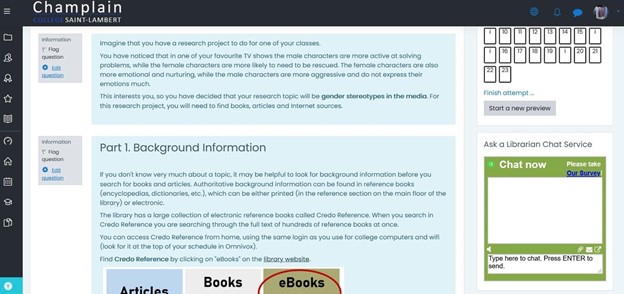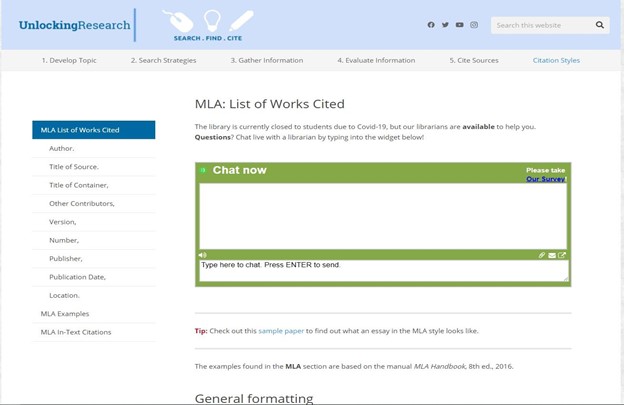Champlain College St-Lambert Library’s successful implementation of a virtual reference desk
When the COVID pandemic closed down the colleges in the spring of 2020, we had to figure out the most efficient way to provide virtual services for our library users. Students use chat platforms to communicate with each other every day, so why not have them message a librarian for help? A platform, called Library H3lp, facilitates real-time chat in order for libraries to help their clients online. We used the platform to set up the Ask Us, Virtual Reference Desk at Champlain College Saint-Lambert.
There was instant buy-in from the faculty and students. There were days in the fall of 2020 when library staff participated in 20 to 30 chats a day. Sometimes it was just a quick question and other times it was something a little more involved.
How the Virtual Reference Desk works
The library chat box is available throughout the library’s websites and in Moodle. Wherever students go they are reminded of the library services and can easily access the chat box to get help from the Virtual Reference Desk. If the chat box is visible, it means that the service is live. After normal library hours, when the chat box is not live, an “Ask Us” form appears, and students can send in their questions that will be answered first thing in the morning.
During theintroduction to research orientation sessions given in various courses at the start of the semester, the library staff gives a demonstration on how to use the chat service. We have found that when the students see how fast the reply can be, they are more likely to use the Virtual Reference Desk afterwards.
Providing students with help virtually is becoming more and more popular. A live response from library staff is very effective because it comes “at the point of need”. It is entirely responsive to and wholly driven by the student’s needs.
It reduces the students’ anxiety to know that there is someone there to help them when they need help. At Champlain St-Lambert, 2 librarians and 2 documentation technicians work at the virtual help desk. As the library staff members were working from home during the campus closure, we decided to designate one person each day to act as the primary point person on the chat, while the others would be logged on as backup, ready to jump when the main person was unavailable or already busy with other questions
Of course, student behaviour in the online environment is not markedly different from their behaviour on campus. They try to complete their assignment and have their questions answered in the last half hour before the library closes. When there is an onslaught of questions, 2 or 3 staff members answer chats at the same time.
If teachers have questions when they are with a student during their office hours they can easily use the chat box on the library website, and the staff will respond immediately.
An advantage of using the Library H3lp platform is that the staff member who receives a question in the chat can see the URL of the website where the student is using the chat box. That gives us a clue as to what type of question the student might ask and helps us prepare to answer. If they are on the library’s “Unlocking Research” citation page, the student likely has a question about MLA, APA or Chicago citation format. If they are on the library website, they probably have a question about where to find resources. Yes, we can see the students’ session number; however, the chat is anonymous, in other words, we won’t know the student’s name. Students can come back even if they close the chat box! If they do not close the chat box, they can continue to type subsequent questions in the same chat box and we will know it is the same student and be able to see the earlier interaction.
This project is not just one person’s responsibility. Unknown to the students, staff has been collaborating behind the scenes in order to seamlessly provide answers to them. Staff members have to come together as a team and each person in the team brings their own expertise. For instance, one person can be more familiar with the Chicago than the MLA citation style. We set up a subgroup for the reference desk staff on Microsoft Teams so that if one person is stumped while helping a student, they can rapidly get help from other staff members.
How can I help you?
During a chat session, we follow similar procedures to a transaction at the physical reference desk, going through is known as a “reference interview” in order to determine the student’s actual need.
We have to remember that some students have never actually set foot on campus and this is their first foray into research. Students coming into CEGEP lack experience doing research. Many don’t know the difference between a book, a chapter in a book or a journal article. Elementary and secondary students are often asked to read books from page 1 to 300 in a linear fashion. They don’t have the experience of using non-fiction or scholarly material. So, students often don’t know that there is an index, a table of contents, etc. Trying to explain some of these concepts in a virtual world is a challenge and can take a while. Other times we realise the student hasn’t read the teacher’s instructions properly.
When you start answering the students, you start realising that helping is very gratifying and that you are making a difference.
Feedback
The most satisfying outcome for the students was the immediate response they would get on the chat. “You answer so quickly, are you a real person or a bot?” It is a positive surprise for the students to realise that there is an actual person answering their question live. In the context of students not having contact with anybody on campus, it gives them a sense of connection. Some of the faculty has also been taken aback, “Oh, you answer right away!”
Quickness of the reply, usefulness of the information, librarian live chat was my guardian angel. Extremely polite, helpful staff who go out of their way to help, the greatest part of online school: talking to humans.
Final thoughts
The Virtual Reference Desk is one way we have found that directly contributes to the students’ success. It’s a project that we implemented for the pandemic, but I will be looking into the budget to see if that service will be able to continue when students return to life on campus.
Students tell me you’ve saved my life, but I tell them no, you saved your life by reaching out first. You have to reach out to be saved.
Editor’s note
Profweb would like to thank Lucie Delhomme for her collaboration on this article. Lucie Delhomme who is in charge of the Regroupement des bibliothèques collégiales du Québec (REBICQ) a Quebec college library group introduced us to the Virtual Reference Desk following a December 2020 meeting of the group attended by 22 librarians from different colleges. The librarians talked about how libraries were adapting their services during the pandemic. About half of the colleges represented use a chat tool for their virtual reference desk. Some of these colleges used a chat tool before the pandemic but with mitigated success. Most of the college librarians use e-mail or MIO (Omnivox Portal’s messaging service) to reach out to students. A lot of them mentioned that they would answer a quick question using a chat but to give more elaborate explanations they would meet with the student on <ahref=”https: zoom.us=”” “=””>Zoom or Microsoft Teams. Many librarians, like Nicole Haché, were pioneers in implementing a virtual help desk and inspired other of their college’s services to implement their own virtual information or help desk during the pandemic.</ahref=”https:>





